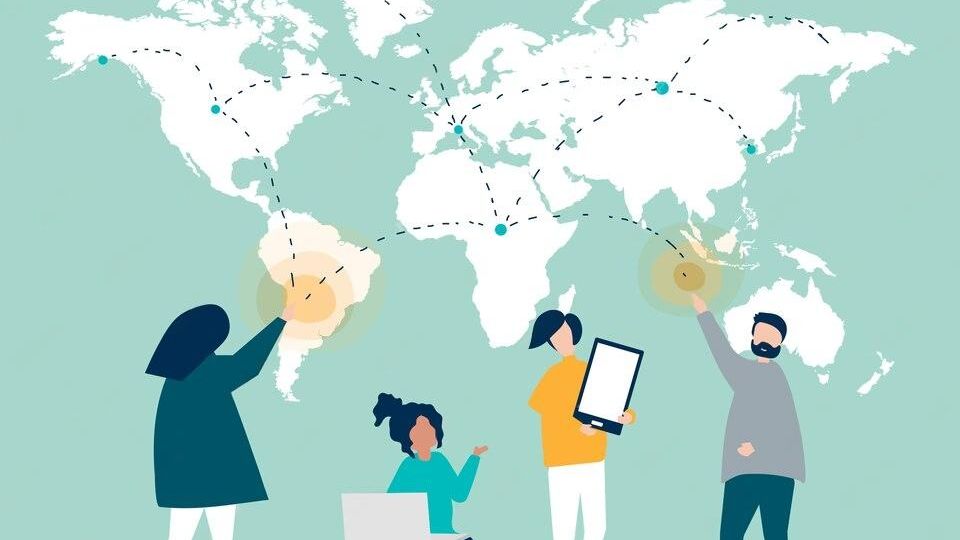
In today’s rapidly changing world, the landscape of international student exchanges has undergone a remarkable transformation due to the integration of digital technology. The traditional model of student exchanges, which relied heavily on physical mobility, has given way to innovative digital platforms and virtual exchange programs. This shift has not only opened up new avenues for global learning but also brought with it unique challenges. This article explores the evolution of international student exchanges in the digital age, shedding light on how technology has redefined the way students connect across borders and learn from one another.
International student exchanges have long been a cornerstone of global education. These programs offer students the opportunity to experience different cultures, gain new perspectives, and expand their horizons. Traditionally, this involved students physically traveling to foreign countries, enrolling in host institutions, and immersing themselves in a new environment. However, with the advent of the digital age, the concept of international student exchanges has expanded to include virtual experiences, making education more accessible and diverse.
The Traditional Model of International Student Exchanges
The Beginnings of Student Exchanges The roots of international student exchanges can be traced back to the Middle Ages, when scholars would travel between universities to gain knowledge. In the 20th century, formal exchange programs between countries started to take shape. These programs aimed to promote cultural understanding and foster international relationships. Students would typically spend a semester or more studying in a foreign country, living with host families, and experiencing daily life in a new culture.
Challenges Faced in Traditional Exchanges While traditional exchanges were highly beneficial in many ways, they had their limitations. Challenges such as high costs, visa restrictions, and language barriers often deterred students from participating. Additionally, there was a lack of diversity in the locations students could choose from, limiting their exposure to different cultures.
The Impact of Technology
The digital revolution has dramatically reshaped the landscape of international student exchanges. Today, students have access to a wide range of digital tools and resources that have made cross-border learning more accessible and flexible than ever before.
Digital Tools Transforming Student Exchanges Digital technology has enabled the creation of online platforms that connect students worldwide. These platforms provide tools for video conferencing, collaboration, and content sharing, making it possible for students to engage in cross-cultural experiences without leaving their homes. Such tools have made it easier for institutions to set up partnerships and offer virtual exchange programs.
Advantages and Drawbacks of Digital Tools The use of digital tools in student exchanges comes with several advantages. They eliminate the need for physical travel, reducing costs and environmental impact. Moreover, students can engage in exchanges without the constraints of time zones or geographical distances. However, there are also drawbacks, such as potential technological barriers and the loss of face-to-face interactions.
Virtual Exchange Programs
Definition and Types Virtual exchange programs, also known as remote or online exchanges, are a modern iteration of international student exchanges. These programs leverage digital tools and platforms to facilitate cross-cultural interactions. There are various types of virtual exchanges, including synchronous exchanges, where students engage in real-time conversations, and asynchronous exchanges, which involve communication across time zones.
Benefits of Virtual Exchanges Virtual exchanges have brought about a host of benefits for students and institutions. They offer a broader range of cultural experiences by connecting students from diverse backgrounds. Participants can develop intercultural communication skills, improve language proficiency, and explore global issues from the comfort of their own homes. Additionally, virtual exchanges are more cost-effective, making them accessible to a wider audience.
Global Learning Communities
How Online Platforms Connect Students Online platforms play a pivotal role in creating global learning communities. These platforms serve as meeting points for students and instructors from around the world. Students can engage in discussions, collaborate on projects, and participate in joint courses with peers from different countries. This interconnectedness fosters a sense of global citizenship and cultural appreciation.
Case Studies Several institutions and organizations have successfully implemented digital platforms to create global learning communities. For example, the “COIL” (Collaborative Online International Learning) initiative connects students and faculty globally to collaborate on projects and courses. Such initiatives have been instrumental in promoting cross-cultural understanding and fostering global partnerships.
Overcoming Barriers in Digital Exchanges
Addressing the Digital Divide One of the primary challenges in the digital age is the digital divide, which refers to disparities in access to technology. To ensure that international student exchanges are inclusive, efforts must be made to bridge this divide. Institutions and organizations are working on providing access to technology and the internet for underprivileged students, ensuring that no one is left behind.
Cross-cultural Communication Challenges While technology has made it easier for students to connect across borders, cross-cultural communication remains a significant challenge. Misunderstandings, differing communication styles, and language barriers can hinder effective exchange experiences. Institutions are developing programs to help students navigate these challenges and build essential intercultural communication skills.
Preparing for the Future
The evolution of international student exchanges is an ongoing process. As technology continues to advance, it is essential to look ahead and anticipate the future of global education.
Trends in International Student Exchanges Several trends are shaping the future of international student exchanges. The use of virtual reality (VR) and augmented reality (AR) technologies is expected to provide immersive cross-cultural experiences. Additionally, more focus is being placed on interdisciplinary exchanges and addressing global challenges collaboratively.
Future Possibilities and Innovations In the coming years, we can expect to see even more innovations in the field of international student exchanges. As technology improves, the line between physical and virtual exchanges may blur, creating hybrid programs that offer the best of both worlds. Furthermore, blockchain technology may revolutionize the validation and recognition of exchange experiences, making it easier for students to receive credit for their international learning experiences.
Conclusion
The digital age has ushered in a new era for international student exchanges, redefining how students connect, learn, and grow across borders. While traditional exchanges continue to be valuable, the integration of digital tools and virtual exchange programs has expanded the horizons of education. As we look to the future, it is essential to embrace the opportunities and challenges that the digital age brings to international student exchanges, striving for inclusivity and promoting global citizenship.




